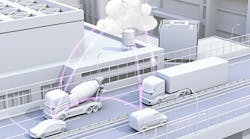Ship Smarter: Building a Competitive Advantage with a Connected Tech Ecosystem
More than ever, companies are under pressure to provide as much information as possible with minimal delay, lower overhead and exacting specificity. Smart companies know that investing in data-driven intelligence can give them the edge they need to rise above the competition. But what are the key components needed to build a next generation, data-driven transportation and logistics ecosystem? What technologies—and support—are needed to ensure that your company is delivering the efficiency, transparency and responsiveness that today’s supply chain demands?
For companies looking to invest in a competitive, future-proofed infrastructure, they need to understand where supply chain technology is going—and where it’s going is “the edge.”
Understanding the Edge
While the Internet of Things, or IoT, has been a buzzword for a decade or more, the term commonly referred to a centralized system where simple networked sensors shared data back to a server which could be used to better understand and control complex processes. But the next step in this technological evolution is about decentralizing the computing process and moving computation and analysis from a single hub to the multitude of devices that gather data—sensors on machines, telemetrics systems in fleet vehicles, RFID scanners in warehouses and retail facilities, and mobile computing devices used by workers. This has been driven by the development of smaller, more affordable and more power-efficient chips designed to meet the needs of an increasingly mobile world.
This move to the edge means that IoT devices can pack significant processing capabilities—machines that can talk to each other directly, tracking solutions that make real-time updates to inventory systems, employees who are able to do real, substantive analysis on mobile devices—and all of this is able to help constantly streamline workflows and identify potential challenges before they erupt into something more costly. Moving to “the edge” enables technologies like machine learning and AI that can understand data better and faster than a human operator, generating deep insights into complex processes that help keep pace with the demands of today’s market.
As expectations grow, the companies that succeed will be the ones that are best able to capture data across their organization and translate it into actionable intelligence for their workforces. But what do you need to ensure your organization can compete?
Choosing the Right Connected Technology to Keep You Competitive
In a fast-moving industry with thin margins, a technology ecosystem is only as valuable as its performance on its worst day—this means global, seamless connectivity and making sure you have the right equipment, devices and applications that are adaptable, secure and properly managed to get the job done. Companies looking to invest in this next generation of edge computing will have to ensure that every part of their technology chain is enterprise-grade. The devices, software and services that come together to enable “the edge” need to be reliable, robust and designed at their core to handle large amounts of data from disparate sources.
In short, the crucial components of an edge ecosystem are:
● A network of smart, connected devices that constantly generate vital data on all activity within your supply chain with as little downtime as possible.
● Reliable connectivity that ensures that the most widespread supply chains stay in constant contact regardless of geography.
● Smart software that can take disparate, complex data and translate it into actionable intelligence for you and your workforce.
Let’s look at the first component—the devices that will gather and analyze the data from your supply chain and turn that data into actionable intelligence close to or at the source of capture. For the warehouse, transportation and logistics space, a lot of data will need to be generated by automated devices with built-in sensors and computing capabilities. For instance, RFID scanners can keep track of where an inventory item is and instantly share that information with devices throughout a network. Similarly, machines like conveyors, guided forklifts or wrapping machines include smart sensors that can recognize maintenance concerns, process inefficiencies or order accuracy instantaneously.
But the edge IoT isn’t just about automated sensors—it’s also about equipping workers with devices that let them become part of the data capture process as well.
For instance, as truck drivers are directed towards electronic logging as they look to comply with the ELD mandate, they can also become data generators. Handheld computing devices meet the needs of the ELD mandate but deliver even more valuable data that can make fleet management more efficient than ever—information like the status of loading docks, the need for refrigerated or other specialty trucks, when a customer is available to accept delivery, and more. So in addition to a safety benefit, an enterprise mobile tablet or handheld used for electronic logging can also provide valuable insights into where shipments are and when they can be expected to be delivered.
In the warehouse as well, equipping workers with rugged handheld devices offers them a window into the edge IoT network to better monitor and understand data as it’s being generated. This means a workforce that can spend more time addressing inefficiencies and heading off challenges before they become problems.
Second, a modern connected ecosystem is only as good as its ability to stay connected. As demands on data grow and supply chains become increasingly global, connected technology must match this scope and scale. A truly powerful edge network is not about connecting one facility or one fleet of trucks; it’s about a global network of devices and workers sharing insightful data as fast as possible, with as much computation done at the source of the data as possible. This means you must have reliable and high-speed data connectivity across a network, no matter where a job might take you. A factory in Poland needs to “speak” with a rail car container carrying goods in the Middle East which needs to be able to share data with a warehouse in Baltimore which needs to talk to a distribution center in Indianapolis—and for the end user, all of this needs to happen seamlessly and on-demand.
Third, you need software that can truly make sense of all of this data and provide a unifying voice for automated business intelligence. Even with much of the computation being done at the edge, end users need to be able to have a view into these complex systems that empowers them to understand and act on the data being collected. And whether someone is accessing the network from a desktop terminal, a laptop, a tablet, or a handheld device, they must be able to view, interact with and adjust processes wherever, whenever. That means working with a technology partner that can ensure you have the right software for your needs, as well as the ability to access it from a variety of devices and operating systems.
Lastly, investing in “the edge” and leaning on it for a competitive advantage means you need to ensure that if and when there is a technical issue or maintenance needed, you have a service partner that can provide 24-hour support and fast turnaround on servicing and repair of your mobile workforce devices. The best supply chain is only as good as its ability to be resilient in the face of unexpected downtime.
And for each of these critical components, it’s essential that an organization ensure they are protected by enterprise-grade security. As more capital is invested in connected systems, maintaining their integrity becomes a paramount concern. This means that you should be certain that you’re protected at all three levels: hardware (handheld devices or automated machines), at the network level, and at the software level.
Smart Solutions for the Edge Ecosystem
The growing demands on supply chain and logistics organizations are coupled with often-shrinking IT departments. This means that companies that want to stay competitive are turning more and more to vendors who can help them tackle today’s technology challenges. The deployment of an intelligent, data-generating network is a major, large-scale challenge that requires immense expertise in deploying, installing, training and servicing a network made up of multiple kinds of devices and software across many geographies.
Identifying a vendor who can provide a full-scale solution—versus just a device or piece of software—alleviates pressures on already stretched IT staffs and reduces the complexity involved in maintaining a system over its life. For today’s organizations looking to maximize efficiency through a connected ecosystem, finding the right partner is key to ensuring success.
Jim Dempsey is business development manager with Panasonic Corporation of North America, a technology partner and integrator to businesses, government agencies and consumers.



